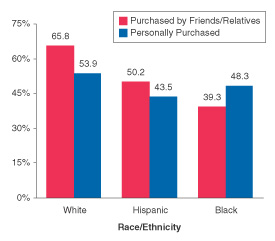
November 22, 2002

November 22, 2002
|
In Brief |
|
The National Household Survey on Drug Abuse (NHSDA) asks respondents aged 12 or older to report whether they smoked cigarettes during the month before the survey interview. Youths aged 12 to 17 who reported past month smoking were asked about how they got their cigarettes during this time period.1
Figure 1. Percentages of Youths Aged 12 to 17 Reporting Past Month Cigarette Use, by Age Group: 2001 |
Table 1. Percentages of Past Month Cigarette Smokers Aged 12 to 17 Reporting Source of Their Cigarettes During the Past Month:* 2001 |
 |
 |
Although it is illegal in the United States to sell tobacco to underaged youths, in 2001 almost 2 million youths aged 12 to 17 who smoked cigarettes in the past month purchased them personally during the same time period. The proportion of past month youth smokers who bought their own cigarettes during the past month fell from 59 percent in 2000 to 52 percent in 2001. The proportion of past month smokers aged 12 to 17 who bought cigarettes at a store where a clerk handed out cigarettes fell from 34 percent in 2000 to 29 percent in 2001. This decline was largely attributable to youth smokers aged 14 to 17. In 2001, approximately 28 percent of past month smokers aged 12 to 17 bought cigarettes at small stores, convenience stores, or gas stations, and 28 percent bought them from a friend, relative, or someone at school. The percentage of past month youth smokers reporting no cigarette purchase (either through friends or relatives or by themselves) during the past month increased from 19 percent in 2000 to 25 percent in 2001.
Figure 2. Percentages of Past Month Cigarette Smokers Aged 12 to 17 Reporting Source of Their Cigarettes During the Past Month:* 2000 and 2001 |
Table 2. Percentages and Standard Errors of Percentages of Past Month Cigarette Smokers Aged 12 to 17 Reporting Source of Their Cigarettes During the Past Month,* by Age Group: 2001 |
 |
 |
Figure 3. Percentages of Past Month Cigarette Smokers Aged 12 to 17 Reporting Source of Their Cigarettes During the Past Month,* by Race/Ethnicity:** 2001 |
 |
**Small sample sizes prevented analyses of American Indians/Alaska Natives or Asians.
Source (Figure 2): SAMHSA 2000 and 2001 NHSDAs.
Source (other tables and figures): SAMHSA 2001 NHSDA.
| The National Household Survey on Drug Abuse (NHSDA) is an annual survey sponsored by the Substance Abuse and Mental Health Services Administration (SAMHSA). The 2000 and 2001 data are based on information obtained from 141,000 persons aged 12 or older (approximately 70,000 each year), including more than 48,000 youths aged 12 to 17 (approximately 24,000 each year). The survey collects data by administering questionnaires to a representative sample of the population through face–to–face interviews at their place of residence.
The NHSDA Report is prepared by the Office of Applied Studies (OAS), SAMHSA, and by RTI in Research Triangle Park, North Carolina. Information and data for this issue are based on the following publication and statistics: Office of Applied Studies. (2001). Summary of findings from the 2000 National Household Survey on Drug Abuse (DHHS Publication No. SMA 01–3549, NHSDA Series: H–13). Rockville, MD: Substance Abuse and Mental Health Services Administration. Office of Applied Studies. (2002). Results from the 2001 National Household Survey on Drug Abuse: Volume I. Summary of national findings (DHHS Publication No. SMA 02–3758, NHSDA Series H–17). Rockville, MD: Substance Abuse and Mental Health Services Administration. Also available on–line: http://www.oas.samhsa.gov/nhsda.htm. Additional tables available on request. |
| The NHSDA Report is
published periodically by the Office of Applied
Studies, Substance Abuse and Mental Health Services Administration
(SAMHSA). All material appearing in this report is in the public domain
and may be reproduced or copied without permission from SAMHSA.
Additional copies of this fact sheet may be downloaded from http://www.oas.samhsa.gov/facts.cfm.
Citation of the source is appreciated.
Other reports from the Office of Applied Studies are also available on-line on the OAS home page: http://www.oas.samhsa.gov |
|
|
||||||||||||
 |
Click to Return to OAS Home Page |
|||||||||||
|
|
||||||||||||